BULLETIN

“Es bleibt ein unumstößliches Gesetz der Geschichte, daß sie gerade den Zeitgenossen versagt, die großen Bewegungen, die ihre Zeit bestimmen, schon in ihren ersten Anfängen zu erkennen.”
“It remains an indisputable historical law that history will not allow contemporaries to recognize the first stirrings of the great movements which define their era.”
“It remains an indisputable historical law that history will not allow contemporaries to recognize the first stirrings of the great movements which define their era.”
“Quant aux gens que j’accuse, je ne les connais pas, je ne les ai jamais vus, je n’ai contre eux ni rancune ni haine. Ils ne sont pour moi que des entités, des esprits de malfaisance sociale. Et l’acte que j’accomplis ici n’est qu’un moyen révolutionnaire pour hâter l’explosion de la vérité et de la justice.”
“As for the people I am accusing, I do not know them, I have never seen them, and I bear them neither resentment nor hatred. To me they are mere entities, spirits of social evil. And the act I am accomplishing here is no more than a revolutionary way to hasten the explosion of truth and justice.”
“As for the people I am accusing, I do not know them, I have never seen them, and I bear them neither resentment nor hatred. To me they are mere entities, spirits of social evil. And the act I am accomplishing here is no more than a revolutionary way to hasten the explosion of truth and justice.”
Émile Zola, “Letter to Mr. Félix Faure. President of the Republic” in: L’Aurore, January 13, 1898
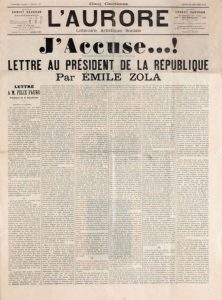
caption verso:
Hitler Starts Drive to Capture Reichstag Majority.
Before a frantically cheering crowd which packed the huge sportspalast in Berlin, Feb. 10, chancellor Adolf Hitler, firing the opening gun in his drive to capture a Reichstag majority in the election March 5, blamed socialist governments for all of Germany’s ills. He is shown here delivering his fiery speech in the Sportspalast.
Hitler Starts Drive to Capture Reichstag Majority.
Before a frantically cheering crowd which packed the huge sportspalast in Berlin, Feb. 10, chancellor Adolf Hitler, firing the opening gun in his drive to capture a Reichstag majority in the election March 5, blamed socialist governments for all of Germany’s ills. He is shown here delivering his fiery speech in the Sportspalast.

“Die große Arbeitslosigkeit, die der wirtschaftlichen folgende seelische Depression, die Sucht sich zu betäuben, die Aktivität bedenkenloser Parteien, das waren die Sturmzeichen der nahenden Krise. Und auch die unheimliche Stille vor dem Sturm fehlte nicht, – die einer epidemischen Lähmung gleichende Trägheit der Herzen. Es trieb manche, sich dem Sturm und der Stille entgegenzustellen. Sie wurden beiseitegeschoben. Lieber hörte man Jahrmarktschreiern und Trommlern zu, die ihre Senfpflaster und Patentlösungen anpriesen. Man lief ihnen nach, hinein in den Abgrund, in dem wir nun, mehr tot als lebendig, angekommen sind.”
“The high unemployment, the spiritual Depression following from the economic, the addict’s urge to numb oneself, the activity of unscrupulous parties, all of these were the signs of the coming storm. And neither was the eerie silence before the storm missing – the languor of a heart, crippled as if by epidemic. It drove some to set themselves against the storm and its stillness. They were pushed aside. People would rather listen to the hollering carnival barkers and drummers hawk their panaceas and snake oil. They ran after them, out into the abyss, in which we now, more dead than alive, have arrived.”
“The high unemployment, the spiritual Depression following from the economic, the addict’s urge to numb oneself, the activity of unscrupulous parties, all of these were the signs of the coming storm. And neither was the eerie silence before the storm missing – the languor of a heart, crippled as if by epidemic. It drove some to set themselves against the storm and its stillness. They were pushed aside. People would rather listen to the hollering carnival barkers and drummers hawk their panaceas and snake oil. They ran after them, out into the abyss, in which we now, more dead than alive, have arrived.”
caption verso:
When Hitler Became Chancellor
Standing in the window at upper left, President Paul von Hindenburg silently acknowledges the cheers of thousands who journeyed to the palace to acclaim him after his appointment of Adolf Hitler as chancellor of Germany, in Berlin.
When Hitler Became Chancellor
Standing in the window at upper left, President Paul von Hindenburg silently acknowledges the cheers of thousands who journeyed to the palace to acclaim him after his appointment of Adolf Hitler as chancellor of Germany, in Berlin.

“So übten sie vorsichtig ihre Methode: immer nur eine Dosis und nach der Dosis eine kleine Pause. Immer nur eine einzelne Pille und dann einen Augenblick Abwartens, ob sie nicht zu stark gewesen, ob das Weltgewissen diese Dosis noch vertrage. Und da das europäische Gewissen – zum Schaden und zur Schmach unserer Zivilisation – eifrigst seine Unbeteiligtheit betonte, weil diese Gewalttaten doch ‘jenseits der Grenze’ vor sich gingen, wurden die Dosen immer kräftiger, bis schließlich ganz Europa an ihnen zugrunde ging.”
“So they carefully practiced their method: always only one dose at a time, and after that dose a short break. Always only one single pill at a time, and then a moment to wait and see if that hadn’t been too strong, if the world’s conscience could still tolerate the dosage. And as the European conscience – to the detriment and disgrace of our civilization – stressed zealously its indifference, since after all these acts of violence were happening ‘that side of the border,’ the doses grew ever stronger, until finally all of Europe perished from them.”
“So they carefully practiced their method: always only one dose at a time, and after that dose a short break. Always only one single pill at a time, and then a moment to wait and see if that hadn’t been too strong, if the world’s conscience could still tolerate the dosage. And as the European conscience – to the detriment and disgrace of our civilization – stressed zealously its indifference, since after all these acts of violence were happening ‘that side of the border,’ the doses grew ever stronger, until finally all of Europe perished from them.”
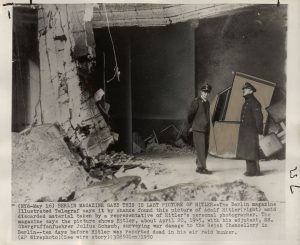
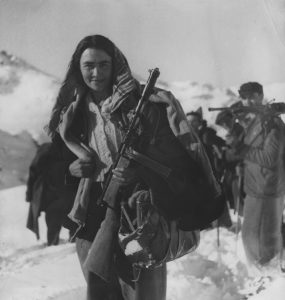

caption verso:
An East German mother cries while saying goodbye to her daughter outside the West German Embassy in Prague, Czechoslovakia. The mother returned to East Germany Saturday, and the daughter stayed with more than 3,000 refugees who left for the West Sunday
An East German mother cries while saying goodbye to her daughter outside the West German Embassy in Prague, Czechoslovakia. The mother returned to East Germany Saturday, and the daughter stayed with more than 3,000 refugees who left for the West Sunday

caption verso:
East German citizens, using ladders built from boards, scale the walls of the West German Embassy in Prague, Czechosslovakia, in a desperate attempt to reach the first step in their bid for freedom.
East German citizens, using ladders built from boards, scale the walls of the West German Embassy in Prague, Czechosslovakia, in a desperate attempt to reach the first step in their bid for freedom.
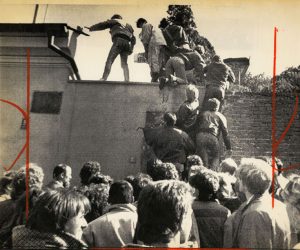
caption verso:
Accompanied by her boy friend, this blonde West Berlin girl stands on a precarious perch near the top of the wall to talk with her mother on the East Berlin side. While it’s just an exciting tourist attraction for many, it’s a heart-breaking “visiting room” for the enormous prison that East Berlin has become for some.
Accompanied by her boy friend, this blonde West Berlin girl stands on a precarious perch near the top of the wall to talk with her mother on the East Berlin side. While it’s just an exciting tourist attraction for many, it’s a heart-breaking “visiting room” for the enormous prison that East Berlin has become for some.

caption verso:
Break in the Barrier East Berlin: An East German border guard stands on duty at the hole in the Berlin dividing wall, which was caused by a truck attempting to break through to freedom in West Berlin. Two men in the truck which rammed the wall had to flee under a hail of bullets after the vehicle was stopped by the wall. Reports said the two men escaped on foot as the East German guards fired on them.
Break in the Barrier East Berlin: An East German border guard stands on duty at the hole in the Berlin dividing wall, which was caused by a truck attempting to break through to freedom in West Berlin. Two men in the truck which rammed the wall had to flee under a hail of bullets after the vehicle was stopped by the wall. Reports said the two men escaped on foot as the East German guards fired on them.

caption verso:
Berlin: West Berlin police check passes of Russians in civilian dress who are trying to enter the western sector of the city here 11/1, through checkpoint Charlie. The West Berlin police demanded all Russians in civilian dress to prove their identity before they were allowed to continue into West Berlin. The action was apparently approved by the U.S., Britain and France in retaliation for attempts by East German Communist police to restrict movement of Western Allied officials in East Berlin.
Berlin: West Berlin police check passes of Russians in civilian dress who are trying to enter the western sector of the city here 11/1, through checkpoint Charlie. The West Berlin police demanded all Russians in civilian dress to prove their identity before they were allowed to continue into West Berlin. The action was apparently approved by the U.S., Britain and France in retaliation for attempts by East German Communist police to restrict movement of Western Allied officials in East Berlin.
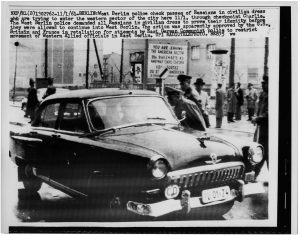
caption verso:
Berlin: Young children play near the Berlin Wall, on the western side. It is a wall that has brought sorrow to many, and freedom to few. Improved security procedures employed by the Communists have cut down the number of attempted and successful escapes. In the background are apartment buildings that are under construction.
Berlin: Young children play near the Berlin Wall, on the western side. It is a wall that has brought sorrow to many, and freedom to few. Improved security procedures employed by the Communists have cut down the number of attempted and successful escapes. In the background are apartment buildings that are under construction.
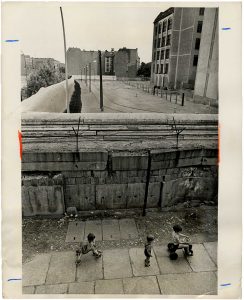
All photographs are available for purchase. Prices upon request. For further information please send an email to: contact@danielblau.com
All offers are noncommital. We cannot guarantee the items are still available on request.
Other Diversions
The US Constitution Basic Law for the Federal Republic of Germany Constitution française du 4 octobre 1958 Costituzione della Repubblica Italiana (Principi fondamentali) Paper on Conflict and Fragility Fact Sheet EU Conflict Early Warning System





 +49 89 29 73 42
+49 89 29 73 42